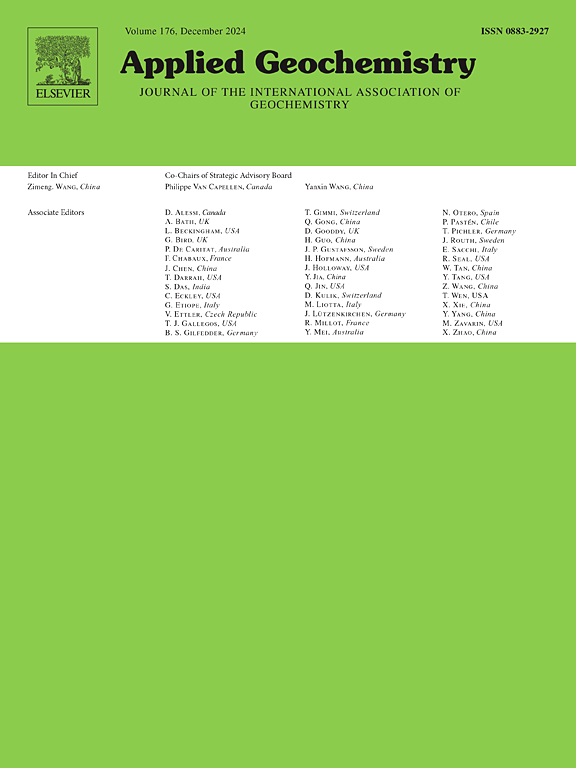Complexation of Cm(III) with monosilicic acid in chloride media
IF 3.4
3区 地球科学
Q1 GEOCHEMISTRY & GEOPHYSICS
引用次数: 0
Abstract
In this work, we present a detailed complexation study of Cm(III) with monosilicic acid in a NaCl medium at low to medium ionic strengths (Im = 0.01–3.00 m). The complexation has been monitored using time-resolved laser fluorescence spectroscopy (TRLFS) in the pHm range of 4–6. The results show that the formation of the monosilicate complex, [Cm(H3SiO4)]2+, is decreased with increasing ionic strength, leading to vast changes in the complex stability constant. Using the Specific Ion Interaction Theory (SIT), we were able to determine the complex stability constant at ionic strength Im = 0 with = 8.1 ± 0.8 and the binary ion-ion interaction coefficient ε ([Cm(H3SiO4)]2+,Cl−) = 0.40 ± 0.04. Additionally, we studied the complexation at elevated temperatures at low to medium ionic strength. Using the van't Hoff equation, = 16.4 ± 0.5 kJ mol−1, = 210 ± 21 J K−1 mol−1 and the free Gibbs Energy = − 46.2 ± 5 kJ mol−1 have been determined. These results show that the complexation reaction is endothermic and driven by an increase of entropy. These novel results obtained in a wide range of various ionic strengths are very important for the modeling of actinide behavior under near-field conditions of a nuclear waste repository in clay formations containing pore and formation waters with increased ionic strength.
氯介质中Cm(III)与单硅酸的络合作用
在这项工作中,我们详细研究了Cm(III)与单硅酸在低至中等离子强度(Im = 0.01-3.00 m)的NaCl介质中的络合作用。利用时间分辨激光荧光光谱(TRLFS)在pHm范围4-6内监测络合作用。结果表明,随着离子强度的增加,单硅酸盐配合物[Cm(H3SiO4)]2+的形成减少,导致配合物稳定常数发生巨大变化。利用比离子相互作用理论(SIT),确定了离子强度Im = 0时配合物的稳定常数,logKm0 = 8.1±0.8,二元离子-离子相互作用系数ε ([Cm(H3SiO4)]2+,Cl−)= 0.40±0.04。此外,我们还研究了低至中等离子强度下的高温络合反应。利用van't Hoff方程,分别求出ΔrHm0 = 16.4±0.5 kJ mol−1,ΔrSm0 = 210±21 jk−1 mol−1,自由吉布斯能ΔrGm0 =−46.2±5 kJ mol−1。结果表明,络合反应是吸热反应,由熵的增加驱动。这些在各种离子强度范围内获得的新结果对于模拟核废料储存库中含有孔隙和离子强度增加的地层水的粘土地层中锕系元素近场条件下的行为非常重要。
本文章由计算机程序翻译,如有差异,请以英文原文为准。
求助全文
约1分钟内获得全文
求助全文
来源期刊

Applied Geochemistry
地学-地球化学与地球物理
CiteScore
6.10
自引率
8.80%
发文量
272
审稿时长
65 days
期刊介绍:
Applied Geochemistry is an international journal devoted to publication of original research papers, rapid research communications and selected review papers in geochemistry and urban geochemistry which have some practical application to an aspect of human endeavour, such as the preservation of the environment, health, waste disposal and the search for resources. Papers on applications of inorganic, organic and isotope geochemistry and geochemical processes are therefore welcome provided they meet the main criterion. Spatial and temporal monitoring case studies are only of interest to our international readership if they present new ideas of broad application.
Topics covered include: (1) Environmental geochemistry (including natural and anthropogenic aspects, and protection and remediation strategies); (2) Hydrogeochemistry (surface and groundwater); (3) Medical (urban) geochemistry; (4) The search for energy resources (in particular unconventional oil and gas or emerging metal resources); (5) Energy exploitation (in particular geothermal energy and CCS); (6) Upgrading of energy and mineral resources where there is a direct geochemical application; and (7) Waste disposal, including nuclear waste disposal.
 求助内容:
求助内容: 应助结果提醒方式:
应助结果提醒方式:


